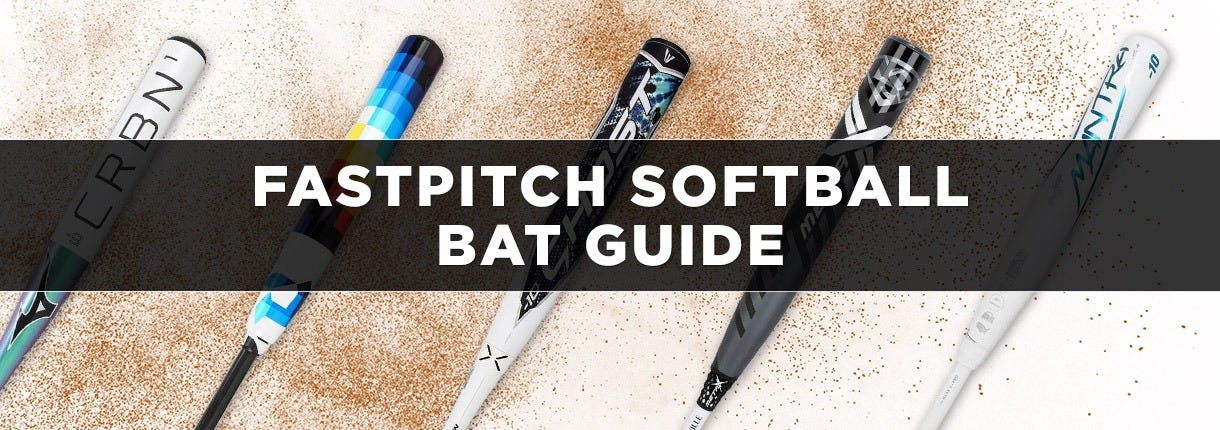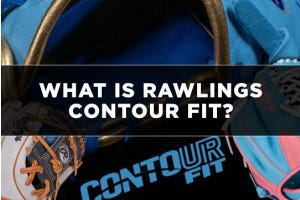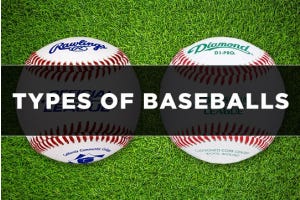How to Choose the Right Fastpitch Softball Bat

Choosing the right bat is crucial to player performance and feeling confident at the plate. The first step in finding the right bat is understanding how to size and fit yourself with the proper fastpitch softball bat. This article will take you step by step in choosing your bat size, types of fastpitch softball bats, bat design, bats by the league, different bat certifications, bat materials, and the best fastpitch softball bats.
This article will cover:
- How to Choose the Right Fastpitch Softball Bat Size (Length and Weight
- Fastpitch Softball Bat Size Chart
- Types of Fastpitch Softball Bats
- Types of Fastpitch Softball Bats by Design
- Fastpitch Softball Bats by League
- Fastpitch Softball Bat Certifications
- Fastpitch Softball Bat Materials
- Best Fastpitch Softball Bats
- FAQ
In order to find the right fastpitch softball bat size, the player must select the length and weight of their bat. With multiple ways to find the proper length and weight, let’s walk through a couple of different ways.
Choosing the Right Fastpitch Softball Bat Length
- Measuring From Your Chest to Fingertips: To begin sizing yourself for a fastpitch softball bat, start by extending your arm horizontally so it is parallel to the ground. After doing so, take a measurement from the center of your chest to your fingertips.
- Finding Bat Length by Height: For the younger players that are at different stages of growth this tactic can be helpful. With the bat knob resting in your palm while standing, hold the bat down at your side and the bat's head should be able to rest on the floor.
- Bat Length by Arm Length: A final technique to find your fastpitch softball bat size is to put the knob of the bat at the center of the chest and extend the bat in front of your chest. If you can grab the barrel of the bat, it is an appropriate length.
Choosing the Right Fastpitch Softball Bat Weight (and Drop)
- Strength Test to Determine Bat Weight: A way to determine if a bat is the correct weight for you is to grab the bottom of the bat handle and extend your arm to the side to where it is even with the shoulder. If the player can hold it there for 30-45 seconds, the bat is a proper weight.
What is a Bat Drop for a Fastpitch Softball Bat?
A bat drop is the difference between the length and weight of the bat. For example, if a bat features a -10 drop weight and it is 33 inches in length, it would weigh 23 ounces.
| Weight/Height | 3'5"- 3'8" | 3'9" - 4' | 4'1"- 4'4" | 4'5"- 4'-8" | 4'9"- 5' | 5'1"- 5'-4" | 5'5"- 5'-8" | 5'9"- 6' | 6'1"- Over' |
|---|---|---|---|---|---|---|---|---|---|
| Under 60 lbs | 27" | 28" | 29" | 29" | |||||
| 61 - 70 lbs | 27" | 28" | 29" | 30" | 30" | ||||
| 71 - 80 lbs | 28" | 28" | 29" | 30" | 30" | 31" | |||
| 81 - 90 lbs | 28" | 29" | 29" | 30" | 30" | 31" | |||
| 91 - 100 lbs | 29" | 29" | 30" | 30" | 31" | 31" | 31" | ||
| 101 - 110 lbs | 29" | 29" | 30" | 30" | 31" | 31" | 32" | ||
| 111 - 120 lbs | 29" | 29" | 30" | 30" | 31" | 31" | 32" | ||
| 121 - 130 lbs | 30" | 30" | 30" | 31" | 32" | 32" | 33" | ||
| 131 - 140 lbs | 30" | 30" | 30" | 31" | 32" | 32" | 33" | 33" | |
| 141 - 150 lbs | 30" | 30" | 31" | 31" | 32" | 33" | 33" | 33" | |
| 151 - 160 lbs | 30" | 31" | 31" | 31" | 32" | 33" | 33" | 34" | |
| 161 - 170 lbs | 31" | 31" | 32" | 32" | 33" | 33" | 34" | ||
| 171 - 180 lbs | 31" | 32" | 32" | 33" | 34" | 34" | |||
| Over 180 lbs | 33" | 33" | 34" | 34" |
Along with the length, weight, and drop of fastpitch softball bats, there are also different types of fastpitch softball bats. Some things to be aware of are the feel of a bat and whether it is a balanced or end-loaded bat, as well as if it is a single-walled bat or a double-walled bat.
Balanced Fastpitch Softball Bats
A balanced fastpitch softball bat will provide the player with better bat speed which will allow them to get the bat through the zone quicker. Balanced fastpitch softball bats are a great option for hitters who are looking for a lot of contact and those who are gap-to-gap hitters.
End-Loaded Fastpitch Softball Bats
End-loaded bats are exactly what it sounds like. The bat will have a little more weight distributed to the end of the bat, making it feel heavier than a balanced bat. End-loaded bats are ideal for the player looking to drive the ball and showcase their power.
Double-Walled Fastpitch Softball Bats
Double-wall fastpitch softball bats feature two barrel walls and are mostly composite bats. Double-wall bats are known for creating a trampoline effect with each swing, thus allowing the ball to ricochet faster off of the bat. Double-walled fastpitch softball bats are a great option for fastpitch players who are more experienced and looking to drive the ball in the gaps and over fences.
Single-Wall Fastpitch Softball Bats
A single-wall fastpitch softball bat features a solid, most of the time aluminum, single-wall barrel. These bats are typically lighter and will feature a larger sweet spot, making it a great option for new players who are learning their swing as well as contact hitters.
One-piece Fastpitch Softball Bats
A one-piece fastpitch softball bat is a single piece of metal, or composite material, that provides a stiffer connection upon contact. This stiffer contact will provide the hitter with more feedback/feel when connecting, as well as supply more power when they square up the ball.
Two-piece Fastpitch Softball Bats
Two-piece fastpitch softball bats are constructed out of two pieces of either metal and composite or both pieces are composite. These two pieces will be connected by a connection piece which will dampen vibration/feedback. Also, two-piece bats will feature more flex with each swing than the traditional one-piece bat.
Depending on age, size, and skill level, different leagues will swing different fastpitch softball bats. From professional softball to tee ball let's take a look at some of the differences.
Women’s Professional Fastpitch
- Age Group: 22+
- Leagues:
- Bat Drop: -8 through -10
- Bat Length: 32in. - 34in.
- Bat Weight: 22oz. - 26oz.
High School/College Softball
- Age Group: 15-22
- Bat Drop: -8 through -10
- Bat Length: 32in. - 34in.
- Bat Weight: 22oz. - 26oz.
Transition Softball
- Age Group: 12-14
- Bat Drop: -9 through -11
- Bat Length: 29in. - 33in.
- Bat Weight: 18oz. - 24oz.
Seniors Softball
- Age Group: 10-11
- Bat Drop: -10 through -12
- Bat Length: 28in. - 32in.
- Bat Weight: 16oz. - 22oz.
Rookie (T-Ball 2) Softball
- Age Group: 7-9
- Bat Drop: -10 through -13
- Bat Length: 26in. - 29in.
- Bat Weight: 13oz. - 19oz.
Tee Ball Softball
- Age Group: 5-6
- Bat Drop: -11 through -13
- Bat Length: 24in. - 26in.
- Bat Weight: 11oz. - 15oz.
Dependent on player age and league standards, fastpitch softball bats will have different bat certifications. Along with this, there are many different bat certifications these bats can feature including ISA, NSA, USA, and USSSA certifications. With all these different certifications, let’s look at what standards these certifications impose on bats.
ISA Bat Certification
ISA stands for Independent Softball Association and is featured alongside most bats with a USSSA stamp. That being said, these bats will meet the 1.20 BPF (Bat Performance Factor) standard that is featured on USSSA softball bats as well.
NSA Bat Certification
Another bat certification to be mindful of is NSA-certified bats. NSA-certified bats will meet the USA (ASA) standard of 98 MPH and USSSA’s 1.20 BPF standard.
USA Bat Certification
USA-certified fastpitch softball bats will adhere to the 98 MPH standard that is imposed. This means that no USA-certified fastpitch softball bat will feature an exit velocity greater than 98 MPH upon contact with the ball. Another thing to know about the USA bat certification is that ASA has changed its name to USA and both USA and ASA stamps will be legal moving forward.
USSSA Bat Certification
Another fastpitch softball bat certification that should be known is the USSSA bat certification. USSSA-certified bats will feature a 1.20 BPF standard on all bats. This means the ball will not rebound more than 20% faster than pitched.
Just like in baseball, fastpitch softball bats will be constructed of different materials. These can include composite, aluminum, a combination of the two, or wood.
Composite Bats
One of the most significant benefits of using a composite fastpitch bat is that it will have a larger sweet spot than its aluminum counterparts. Along with this, another positive aspect of composite bats is that they are mostly two-piece bats. Two-piece bats will have a connection point on the bat and this connection point will dampen vibration as well.
Aluminum Bats
One thing to be mindful of with an aluminum bat is that they will require more advanced hand-eye coordination as these bats will have a slightly smaller sweet spot than composite bats. Aluminum bats will naturally have more vibration than composite bats as they are one-piece bats. That being said, just because they are different materials it does not mean that one bat will outperform the other. When the ball is squared up with a composite or aluminum bat, it will perform at a similar level.
Aluminum Bats
Of all the bat materials, wood will be the least forgiving when compared to composite or aluminum bats. Wood bats will feature the smallest barrel/sweet spot of all materials, which will require exceptional hand-eye coordination. Wood bats are a great option for a player who is training and looking to develop better hand-eye coordination or other hitting skills.
There is not a one-size-fits-all when it comes to choosing the right bat as different bats will work better for different players. One of the most popular fastpitch softball bat series is the Easton Ghost series as you will see several college softball programs using this bat throughout the season. Another reputable fastpitch bat brand is Louisville Slugger which has several bat options such as the popular Meta and LXT bats. Different models within a bat company will feature different constructions, materials, etc. to provide the best option for all player types. Rawlings fastpitch softball bats are also extremely popular throughout college and professional softball leagues. Their Mantra series even includes an innovative knob where the player can put a Blast Softball sensor into the bat to track hits in practice or in the game. Last but not least, DeMarini fastpitch softball bats have been a staple in baseball/softball for years. DeMarini also offers a plethora of options when it comes to finding the perfect bat that fits your playing style such as their CF or Prism series bats. The best fastpitch softball bats are the ones that work best for the player and their playing style.
How to choose a fastpitch softball bat?
A fastpitch softball bat must be the right length, weight, certification, and league appropriate in order to maximize player performance. Being able to find the right bat for each player will help aid in player performance and comfortability in the box.
What size fastpitch softball bat to choose based on age?
The younger the fastpitch softball player, the shorter and lighter the bat will be. For example, a 5 or 6-year-old will swing a 24in.-26in. bat that features anywhere from a -11 to a -13 drop weight. Compared to a player in high school/college where the bats will range from 32in.-34in. and feature anywhere from a -8 to a -10 drop weight typically.
What should I look for in a fastpitch softball bat?
Once someone understands what bat certification they need and what size bat they are looking for, picking a bat is completely reliant on how the player feels with the bat. For example, choosing a balanced bat or an end-loaded bat will play a significant role in player comfortability and confidence at the plate, which in turn affects player performance.
Is a lighter or heavier bat better for a fastpitch softball bat?
A stronger player usually prefers a more end-loaded/heavier bat as this will allow for more powerful swings and contact. However, being able to catch up to pitches and make contact is the most important thing. That being said, for someone who is quick or is a line-drive hitter a more balanced/lighter bat would be a better option.








